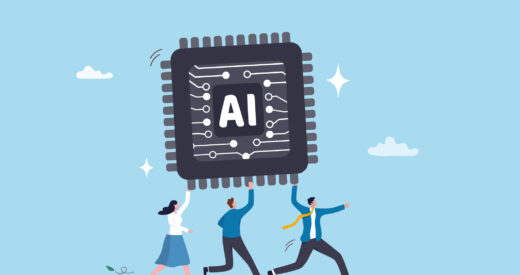Technology impacts the majority of humans on the planet, but there is a vast inequity in who benefits from technological innovation. The opportunity to access, develop, and profit from technology is imbalanced, available mainly to the wealthy, and the connected.
When an industry is controlled by a majority in terms of gender and ethnicity, the result is often bias and discrimination baked into the infrastructure of innovation. This unconscious bias has huge ramifications as technological innovation becomes ingrained into everyday life — from lifestyle-improving tech to the systems governing society. When the technology designed for predictive policing, facial recognition, and bail predictions, among others, are prejudiced, civil rights are at stake.
The Tech Industry’s Diversity Problem
The Western tech industry has an uncomfortable history of overlooking women, and People of Color and writing these pioneers and inventors out of their crucial roles in technological development.
In 2021, the industry is still renowned for major diversity issues. In the UK, only 4% of the tech workforce is Black, Asian, or minority ethnic (BAME). Perceived xenophobia due to the Brexit vote has contributed to a huge loss of skilled foreign professionals from the tech sector, causing the government to introduce attractive working visa packages. This indicates the issue is not currently improving.
Globally, more women and BAME individuals are graduating with Tech degrees than ever before, but the diversity imbalance persists, suggesting there is a widespread issue of problematic company culture.
A study conducted by the Harvard Business Review found that the road to leadership positions is paved differently for women than men. Organizations expect a higher level of qualification and experience from women, and once achieved, fewer resources are provided in terms of funding, team size, and supervisor support.
The study also reports that over half of all female, LGBTQ+, and racial and ethnic minority employees experience daily bias working for tech companies. When staff detect prejudice, experience discrimination, and are passed over for promotion, employee retention decreases and revenue suffers.
In contrast, when teams encompass a diverse range of people, creativity and innovation increase and toxic cultural elements are less likely to develop. More importantly, inclusivity is prioritized as different demographics are represented in design sessions and marketing meetings, avoiding unconscious bias filtering into product and service offerings.
Problematic Applications Of Technology
Technology has the reach and power to influence the pursuit of racial and gender equality, yet there are some major areas within the industry where inequality is being reinforced.
The Gaming industry is such an example. During 2020’s protests against systemic racism and police brutality towards Black Americans, many gaming companies released statements of support and donated to the Black Lives Matter movement. However, this is just a small — and often performative — step toward correcting historic equality issues present in their content.
Until recent years, positive Black and Latinx representation outside of sports games were a rarity, diversity often subverted into villain or sidekick roles with little complexity of character. LQBTQ+ characters were usually missing from mainstream gaming altogether, or only vaguely alluded to. Middle Eastern characters are still seldom seen outside of terrorist roles in war games. Violence and misogyny towards women are common narrative tropes and objectification of the female body is often present regardless of other positive characterizations. Several generations have grown up with these stereotypes and a majority of gamers feel underrepresented or represented in a negative light.
In contrast to the on-screen stats, the most active demographic of gamers in the world are African American teenagers, with 83% of this group playing video games. Yet The International Game Developers Association (IGDA) found that only 2% of games developers worldwide identified as Black in 2019. Along with the serious racial ramifications, this is also a huge missed business opportunity.
Outside of entertainment products, Artificial Intelligence and machine learning is designed to augment the human experience and is currently being integrated into many societal services and systems. This fundamental purpose is lost when everyday technology is programmed with bias. For example, product suggestion algorithms in e-commerce regularly prioritize Caucasian customer demographics in the beauty sector. And one of the world’s leading tech companies, Apple, failed to include the female menstrual cycle in the first release of its HealthKit app. Design team diversity weeds out these blind spots that cause costly flaws in the real-world application of technology.
Redirecting Technological Advancements
As technology gains power and influence, it is a vital time for industry leaders to redirect technology to resolve racial bias. The issues can be tackled by creating inclusive workplaces to encourage diversity in leadership and engaging historical and present realities of race, discrimination, and racial impacts in the design of technology services and products.
Diverse hires should not be sought for tokenism but attracted by a culture built for all human demographics. Inclusive company language that encompasses the full spectrum of gender and sexuality, policies designed to support all types of parents, and recognition of all religious holidays should be the norm. It is the responsibility of company leaders to commit to supporting the needs of every employee and to provide an inclusive environment where sexism, racism, homophobia, and xenophobia are not tolerated.
Artificial intelligence and machine learning have the potential to revolutionize the treatment of minorities when diverse groups of people have input in their design. This technology is implemented in deciding bank loans, screening candidates for roles in recruitment, and policing. Technology is vital in tackling discrimination within the justice system and creating equal opportunities for underrepresented groups to succeed.
In gaming and immersive entertainment, Virtual Reality can be instrumental in delivering a full spectrum of human representation to educate users about minority experiences such as that of immigrants or people with disabilities. Simulated experience has proven to encourage empathy in experiments conducted by Stanford University. Complex, sensitive representation should be integrated into the development of video games to improve the perception of underrepresented demographics.
In the 1960s, when the future applications of computing technology were not yet a reality, civil rights leader and journalist Roy Wilkins famously argued that automated systems could create an environment where race could finally be viewed through an unbiased lens. Instead, technology has been implemented, in many cases, to reinforce systemic racism instead of solve it. We have an opportunity to alter this negative course, but industry leaders must adopt this goal into their core strategies, starting with an inward gaze. By examining the industry’s history of discrimination, the reasons behind the current lack of diversity, and committing to resolving toxic cultures, equality in tech can finally receive foundations to develop from.
Gemma Dodd is a Political Correspondent at Immigration News. She is invested in human rights and informing audiences about social injustice and positive global change.






